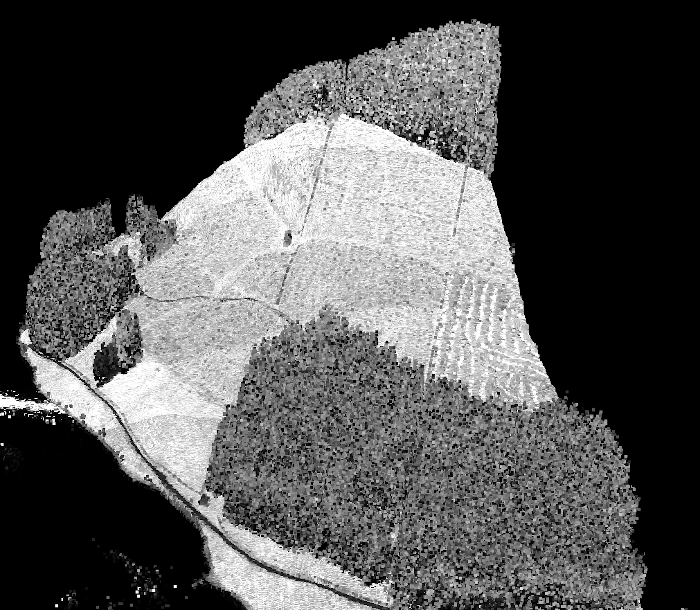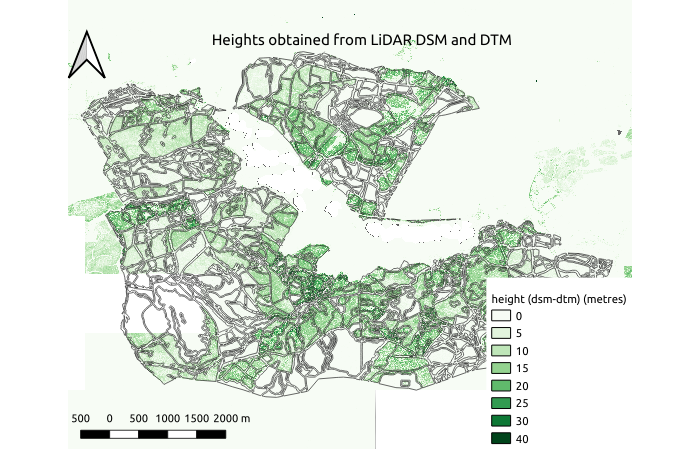Disclaimer: The documents, data and/or models produced here are for interest only and not subjected to formal validation or review. The aim is to explore open data and test its potential in forestry studies. Use at your own risk.
Following previous work using LiDAR data to build a height growth model for Sitka spruce in Arran, the study was repeated in the Carron Valley where the forests are also part of the national forest estate managed by Forestry and Land Scotland. The aim was to test whether the methods were repeatable and what differences could be observed between models constructed from different data.

Figure 1: LiDAR data coverage for part of the Carron Valley. The forest is established around a reservoir (bottom left), roads, clearfells and standing trees are clearly visible. Visualised with plas.io (2019) using LiDAR point cloud data from Scotland Remote Sensing Portal (2019)
Height data was derived by downloading the digital surface model(DSM) and digital terrain models (DTM), merging those into a single raster file then subtracting the DTM from the DSM to obtain a height dataset. The Forestry and Land Scotland database was used to obtain management unit shapes, species and planting years. The management unit shapes were extracted for the Carron Valley and edge effects removed by applying a negative buffer of 10 metres. The resulting shape file was then populated with maximum heights from the height dataset using zonal statistics in QGIS. Stand age was calculated by subtracting the primary component planting year from the observation year recorded in the LiDAR metadata (figure 2). Maximum heights were assumed to be equivalent to the top height of a stand (i.e. height of 100 trees of greatest diameter).

Figure 2: Derived height data combined with forest data from Forestry Commission Open Data (2019)
Only stands where the primary species was Sitka spruce were included in analysis. Data was also filtered to remove stands of age less than 15, height less than 5 metres or age greater than 80. This allowed the exclusion of data related to regeneration on open space with no planting year and trees on failed sites.
A height model was fitted to the Chapman Richards equation using non linear least squares in R. To test the results the model was compared against a Sitka spruce height growth model developed in Ireland using permanent sample plot data and British yield tables published in James (1982).
A model was successfully fitted to the LiDAR data. The growth trend was calculated for a stand based on a site index height of 27.9m (where site index was taken as top height at age 50). This was visualised alongside a model from Lekwadi et al (2012) in figure 3.

Figure 3: Height growth model for the Carron Valley
Table 1: Predicted top heights according to site index (SI) (height at age 50). British YC24 results from James (1982) compared to the equivalent site index of 32.5m from the Carron Valley model and the Irish model.
| Age (years) | SI20 (m) | SI25 (m) | SI30 (m) | SI35 (m) | SI 32.5 (m) | YC24 (m) | Ireland SI 32.5 (m) |
| 20 | 9.6 | 11.9 | 14.4 | 16.8 | 15.6 | 14.1 | 16.4 |
| 30 | 14.3 | 17.9 | 21.4 | 25.0 | 23.2 | 22.0 | 23.7 |
| 40 | 17.7 | 22.1 | 26.5 | 31.0 | 28.8 | 28.2 | 28.9 |
| 50 | 20.0 | 25.0 | 30.0 | 35.0 | 32.5 | 32.5 | 32.5 |
| 60 | 21.5 | 26.9 | 32.3 | 37.6 | 35.0 | 36.0 | 35.0 |
Table 2: Parameter estimates for Chapman-Richards equation for the Carron Valley model
| b0 | b1 | b2 |
| 31.6553319343665 | 0.0464859574062467 | 1.84570382625098 |
The fitted model was nearly identical in output to that produced by the model developed for Ireland by Lekwadi et al (2012). It was also a better fit with historical British yield tables for Sitka spruce in James (1982). This may be due to the better representation of different age classes than datasets from Arran, summary statistics for both datasets are presented in table 3.
Table 3: Summary statistics for Arran and the Carron Valley
| Variable | Arran | Carron Valley |
| Age (years) minimum | 5.00 | 5.00 |
| Age (years) mean | 37.70 | 33.55 |
| Age (years) maximum | 57.00 | 75.00 |
| Height (m) minimum | 2.56 | 2.47 |
| Height (m) mean | 22.18 | 17.75 |
| Height (m) maximum | 35.94 | 37.60 |
Neither dataset included trees close in height to the maximum recorded for Sitka spruce in British conditions (Monumental trees, 2019), so the models will underpredict long term growth and overestimate the site indexes of stands outside their calibration range. However for most commercial applications in Britain Sitka spruce is grown on rotations between 40 and 60 years, so those models cover the growth period of typical stands.
Methods developed to fit anamorphic height growth models in Arran were directly portable to data from the Carron Valley. The fitted models were similar in prediction (within 10%) to models developed independently in Ireland using permanent sample plot data and historical British yield tables upto 60 years.
LiDAR Growth models Sitka spruce Picea sitchensis Carron Valley Forestry Scotland